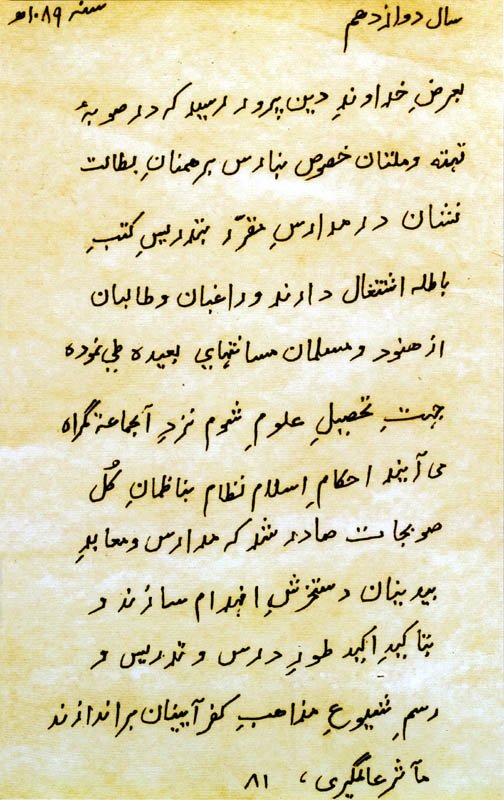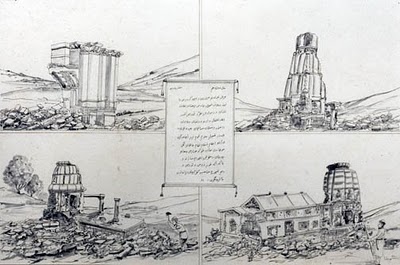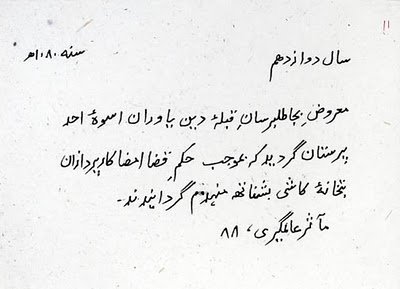History of the Kashi Vishwanath Temple
Varanasi, which was a pious place of pilgrimage for the hindus,The famous Vishwanath Temple has been rebuilt several times. The original was supposed to have been built in 490A.D. However, the original Jyotirlinga of Kashi Vishwanath is not available. The old temple was destroyed as a result of the Mughal invasion.
The Kashi Vishweshwar temple as we see it now was built by Ahalya Devi Holkar in 1777 AD. In 1785 AD, the then King of Kashi, Mansaram and his son Belvant Singh built many more temples near Varanasi. In 1755 AD, the Avadh pantof pratinidhi (representative) got the old temple of Bindumadhava repaired and renovated it beautifully. The kalabhairava temple was built by Srimant Baji Rao Peshwa in 1852 AD.
King Ranjit Singh had the Kashi Vishwanath temple towers covered in gold. A huge bell hangs in the temple. It was donated by the King of Nepal. Surrounding Saranath, there are many Budhhist stupas, Viharas and Chaitra grihas. In 1931 AD the mahabodhi society had built a very beautiful Buddha temple in Saranath.
The Hindu devotees visit Kashi to make offering. Here they perform many rituals and consider themselves blessed. Along side, several foreign tourists visit this place regularly. Places worth seeing include Ghats, temples, tapobhoomi and the scenic beauty of the surroundings. Kashi Kshetra and Sri Vishweswara JyotirLinga are connected as the holiest shrines in the world. The Ganga water here is considered as the nectar of the earth. Dying in Kashi or performing the final rites is considered as the way to the Heavens. Kashi - Rameshwar(1) yatra is the prime pilgrimage for the Hindus.
The popular story regarding Aurangzeb Demolish the Kashi Vishvanath Temple
"While Aurangzeb was passing near Varanasi on his way to Bengal, the Hindu Rajas in his retinue requested that if the halt was made for a day, their Ranis may go to Varanasi, have a dip in the Ganges and pay their homage to Lord Vishwanath. Aurangzeb readily agreed. Army pickets were posted on the five mile route to Varanasi. The Ranis made a journey on the Palkis. They took their dip in the Ganges and went to the Vishwanath temple to pay their homage. After offering Puja all the Ranis returned except one, the Maharani of Kutch.
"A thorough search was made of the temple precincts but the Rani was to be found nowhere. When Aurangzeb came to know of it, he was very much enraged. He sent his senior officers to search for the Rani. Ultimately, they found that the statue of Ganesh which was fixed in the wall was a moveable one. When the statue was moved, they saw a flight of stairs that led to the basement. To their horror, they found the missing Rani dishonoured and crying, deprived of all her ornaments. The basement was just beneath Lord Jagannath's seat. The Rajas expressed their vociferous protests. As the crime was heinous, the Rajas demanded exemplary action. Aurangzeb ordered that as the sacred precincts have been despoiled, Lord Vishvanath may be moved to some other place, the temple be razed to the ground and the Mahant be arrested and punished."
theory launched by B.N. Pande, working chairman of the Gandhi Darshan Samiti and former Governor of Orissa..could B.N. Pande or any of his quoters give the date or even the year of this remarkable episode? One question which we can readily answer is, where did B.N. Pande get this story from? He himself writes: "Dr. Pattabhi Sitaramayya, in his famous book, The Feathers and the Stones, has narrated this fact based on documentary evidence
The document evidence of the story....
"This story of the Benares Musjid was given in a rare manuscript in Lucknow which was in the possession of a respected Mulla who had read it in the Ms. and who though he promised to look it up and give the Ms. to a friend, to whom he had narrated the story, died without fulfilling his promise. The story is little known and the prejudice, we are told, against Aurangazeb persists."
So now, we finally know where the story comes from: an unnamed mullah friend of an unnamed acquaintance of Sitaram ayya's knew of a manuscript, the details of which he took with him in his grave. This is the "document evidence". so we conclude that the popular story is not true and the document evidence not treat as proof.
The real fact to Temple Demolish by Arangzeb
One of the main objectives of Aurangzeb's policy was to demolish Hindu temples. When he ordered (13th October 1666) removal of the carved railing, which Prince Dara Shukoh had presented to Keshava Rai temple at Mathura, he had observed 'In the religion of the Musalmans it is improper even to look at a temple', and that it was totally unbecoming of a Muslim to act like Dara Shukoh ( 13th October 1666).
In 1669, shortly after the death of Mirza Raja Jai Singh of Amber, a general order was issued (9th April 1669) for the demolition of temples and established schools of the Hindus throughout the empire and banning public worship. This was followed by Aurangzeb's order to demolish the highly venerated temple of Vishwanath at Banaras (Persian text),
Temple Destruction by Arangzeb (Proof Documents):
General Order for the Destruction of Temples. (9th April 1669) “The Lord Cherisher of the Faith learnt that in the provinces of Thatta, Multan and especially at Benaras, the Brahmin misbelievers used to teach their false books in their established schools, and their admirers and students, both Hindu and Muslim, used to come from great distances to these misguided men in order to acquire their vile learning. His Majesty, eager to establish Islam, issued orders to the governors of all the provinces to demolish the schools and temples of the infidels, and, with the utmost urgency, put down the teaching and the public practice of the religion of these unbelievers”.
“The Lord Cherisher of the Faith learnt that in the provinces of Thatta, Multan and especially at Benaras, the Brahmin misbelievers used to teach their false books in their established schools, and their admirers and students, both Hindu and Muslim, used to come from great distances to these misguided men in order to acquire their vile learning. His Majesty, eager to establish Islam, issued orders to the governors of all the provinces to demolish the schools and temples of the infidels, and, with the utmost urgency, put down the teaching and the public practice of the religion of these unbelievers”.
Note:
This is not the only instance when Aurangzeb prevented the Muslims from acquiring knowledge and wisdom of the Hindu philosophical works and other Sanskrit and Bhasha classics, or sharing spiritual and intellectual experience, and thus stifled the process of fusion, or at least bridging of the gulf between the two creeds with very different approaches, principles, values, levels of intellectual attainments and period of evolution of ideas. A general order of this type to put down the teaching and public practice of religion by the Hindus was used as a ground to demolish some of the most venerable shrines of India during the next few years, but despite the severe and comprehensive nature of the order, it failed to wrest from Banaras its unique prestige and position as the chief centre of learning of the Vedas, Dharmashastras, the Six Systems of Philosophy, Sanksrit language and literature, and Astronomy.

General Order for the demolition of Hindu Temples.
On the 9th April 1669, Aurangzeb “eager to establish Islam, issued orders to the governors of all the provinces to demolish the schools and temples of the infidels, and, with the utmost urgency, put down the teaching and the public practice of the religion of these unbelievers (Hindus)” Maasir-i-‘Alamgiri, p.81).
In the sketch, the artist has shown the destruction of the temples of Somanath, Jagannath (Puri), Kashi Vishwanath (Banaras)and Keshava Rai (Mathura), which were all highly venerated shrines, as symbolic of Aurangzeb’s ideal of thorough destruction of Hindu temples. In the centre is a portion of the infamous order of the 9th April issued by him.
Demolition of the temple of Viswanath (Banaras). August 1669 A.D. It was reported that, “according to the Emperor’s command, his officers had demolished the temple of Viswanath at Kashi”. (Maasiri-‘ Alamgiri, 88)
It was reported that, “according to the Emperor’s command, his officers had demolished the temple of Viswanath at Kashi”. (Maasiri-‘ Alamgiri, 88)
Note:
Kashi is one of the mort sacred towns in India and reference to the worship of Shiva as Vishveshvara goes back to very early times. Kashi itself enjoys highest sanctity since times immemorial. According to the Puranas, every foot-step taken in Kashi Kshetra has the sanctity of making a pilgrimage to a tirtha. Lord Vishvanatha is regarded as the protector of Kashi and the belief is that one earns great religious merit by having darshana (view) of the deity after having bathed in the Ganges. After destruction of the temple on Aurangzeb’s orders, a mosque was built which still stands there as a testimony of the great tolerance and spirit of forgiveness of the Hindus even towards those who had for centuries desecrated and destroyed their temples and other places of worship and learning, and also as a lesson that “mutually uncongenial cultures”, when forced by circumstances to intermingle in the same Geographical area, result in such calamities. A portion of the sculpture of the demolished temple, probably built in the late 16th century, still survives to tell the fate of Aurangzeb’s vandalism and barbarity. The present temple of Vishveshvara was built by Ahilya Bai Holkar of Indore.
About Benares/Varanasi, we learn from the Maasir-i-Alamgiri: “News came to court that in accordance with the Emperor’s command his officers had demolished the temple of Vishvanath at Banaras”.4 Aurangzeb did not just build an “isolated” mosque on “a” destroyed temple. He ordered all temples destroyed, among them the Kashi Vishvanath, one of the most sacred places of Hinduism, and had mosques built on a number of cleared temple sites.
where is the old Kashi Vishwanath Temple now..
I am very much thankfull to u for letting us know about the truth also i am very much pleased that this filthy aurangzeb was killed by none other than SHIVA'''JI himself ...OM NAMAH SHIVAAY*****
I am very much thankfull to u for letting us know about the truth also i am very much pleased that this filthy aurangzeb was killed by none other than SHIVA'''JI himself ...OM NAMAH SHIVAAY*****
Agreed with you Rajveer,Temple should be rebuilt at old place which is Gyanvapi Mosque and Mosque should be shift 5km away from temple.
The kashi viswanath temple should be built at his original place. Because god shiva and maa parvati had created the whole world from there and if it will not built then whole world will destroy.because whole universe is inside him.he is vishwapita and it is our birth right to correct the mistake made by aurangzeb.om namah shivai
Kasi Viswanath is a Jyotir Linga and a Swayam Bhu= which means that the Linga Manifested itself there..SO IT IS IMPOSSIBLE TO DIG OUT A ABHIR BHAVA LINGA= WHICH APPEARED THERE. Aurangazebs men could not have done any thing to it. The Temple was demolished that is all. SO THE ORIGINAL LINGA MUST BE THERE EXISTING IN THE MOSQUE GYANAVAPI EVEN TODAY. IT IS ALSO SAID THAT K'ABBA IN MECCA IS A SWAYAM BHU MAHADEV LINGA EVEN THOUGH WESTEREN PEOPLE CALL IT A METEORITE STONE.NO INVADER COULD REMOVE KAABA FROM THERE. THE FOLLOWERS OF SANATAN DHARMA HAVE A RIGHT FOR WORSHIP OF THE SWAYAM BHU LINGA WHICH MUST BE OPPOSITE NANDI AND NOW WITHIN THE GYANAVAPI MOSQUE. AS THE INDIAN GOVERNMENT IN ITS SECULAR SOMNOBULANCE CAN NOT DO ANY THING UNITED NATIONS MUST GIVE IT THE STATUS OF WORLD HERITAGE MONUMENT WHERE EVERY ONE CAN GO OFFFER PRAYERS